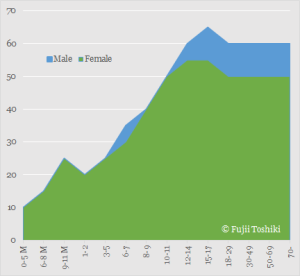
The reports of protein have 9 pages and 73 references in 2010 edition and 14 pages and 119 references in 2015 edition, respectively.
Although upper limit of protein intake is not set in 2010 edition, it’s preferred that protein intake is less than 2.0 g/kg/d in adult.
It is focused on severity of disease in 2015 edition. If protein-energy ratio was greater than 20 % energy, the risk of diabetes, cardiovascular disease, the incidence of cancer, bone loss and the increase of BMI would develop. Then it should be noted that protein-energy ratio should not be more than 20 % energy.
Estimated Average Requirement of indispensable amino acids (essential amino acids) has been described for only adult in 2010 edition and they have been described not only for adult but also for child and infant in 2015 edition, respectively.
Dietary reference intakes of the proteins of the 2015 edition is as follow table.
Dietary Reference Intakes of the proteins (g/d), Target (median) % energy) 2015 edition
| Gender |
Male |
Female |
| Age |
Estimated Average Requirement |
Recommended amount |
Approximate amount |
Target amount (Median) |
Estimated Average Requirement |
Recommended amount |
Approximate amount |
Target amount (Median) |
| 0-5 M |
|
|
10 |
|
|
|
10 |
|
| 6-8 M |
|
|
15 |
|
|
|
15 |
|
| 9-11 M |
|
|
25 |
|
|
|
25 |
|
| 1-2 |
15 |
20 |
|
13-20 (16.5) |
15 |
20 |
|
13-20 (16.5) |
| 3-5 |
20 |
25 |
|
13-20 (16.5) |
20 |
25 |
|
13-20 (16.5) |
| 6-7 |
25 |
35 |
|
13-20 (16.5) |
25 |
30 |
|
13-20 (16.5) |
| 8-9 |
35 |
40 |
|
13-20 (16.5) |
30 |
40 |
|
13-20 (16.5) |
| 10-11 |
40 |
50 |
|
13-20 (16.5) |
40 |
50 |
|
13-20 (16.5) |
| 12-14 |
50 |
60 |
|
13-20 (16.5) |
45 |
55 |
|
13-20 (16.5) |
| 15-17 |
50 |
65 |
|
13-20 (16.5) |
45 |
55 |
|
13-20 (16.5) |
| 18-29 |
50 |
60 |
|
13-20 (16.5) |
40 |
50 |
|
13-20 (16.5) |
| 30-49 |
50 |
60 |
|
13-20 (16.5) |
40 |
50 |
|
13-20 (16.5) |
| 50-69 |
50 |
60 |
|
13-20 (16.5) |
40 |
50 |
|
13-20 (16.5) |
| 70- |
50 |
60 |
|
13-20 (16.5) |
40 |
50 |
|
13-20 (16.5) |
| Additional protein in early pregnant |
|
|
|
|
0 |
0 |
|
|
| Additional protein in mid pregnant |
|
|
|
|
5 |
10 |
|
|
| Additional protein in late pregnant |
|
|
|
|
20 |
25 |
|
|
| Additional protein in lactation |
|
|
|
|
15 |
20 |
|
|
Dietary reference intakes of the proteins of the 2010 edition is as follow table.
Dietary Reference Intakes of the proteins (g/d) 2010 edition
| Gender |
Male |
Female |
| Age |
Estimated Average Requirement |
Recommended amount |
Approximate amount |
Upper limit amount |
Estimated Average Requirement |
Recommended amount |
Approximate amount |
Upper limit amount |
| 0-5 M |
|
|
10 |
|
|
|
10 |
|
| 6-8 M |
|
|
15 |
|
|
|
15 |
|
| 9-11 M |
|
|
25 |
|
|
|
25 |
|
| 1-2 |
15 |
20 |
|
|
15 |
20 |
|
|
| 3-5 |
20 |
25 |
|
|
20 |
25 |
|
|
| 6-7 |
25 |
30 |
|
|
25 |
30 |
|
|
| 8-9 |
30 |
40 |
|
|
30 |
40 |
|
|
| 10-11 |
40 |
45 |
|
|
35 |
45 |
|
|
| 12-14 |
45 |
60 |
|
|
45 |
55 |
|
|
| 15-17 |
50 |
60 |
|
|
45 |
55 |
|
|
| 18-29 |
50 |
60 |
|
|
40 |
50 |
|
|
| 30-49 |
50 |
60 |
|
|
40 |
50 |
|
|
| 50-69 |
50 |
60 |
|
|
40 |
50 |
|
|
| 70- |
50 |
60 |
|
|
40 |
50 |
|
|
| Additional protein in early pregnant |
|
|
|
|
0 |
0 |
|
|
| Additional protein in mid pregnant |
|
|
|
|
5 |
10 |
|
|
| Additional protein in late pregnant |
|
|
|
|
20 |
25 |
|
|
| Additional protein in lactation |
|
|
|
|
15 |
20 |
|
|
The recommended amount is based on the proteins maintain the required amount from nitrogen balance experiment, corrected in the digestibility of daily meal mixed protein, used to calculate the reference value of the Estimated Average Requirement calculation and is calculated the recommended amount by the addition of interindividual variability.
Recommended amount of protein (g/d) is product of Estimated Average Requirement and Recommended amount calculated coefficient. The Estimated Average Requirement is product of Reference value of the Estimated Average Requirement Calculation (g/kg/d) and reference weight (kg). Reference value of the Estimated Average Requirement calculation is obtained by dividing protein maintain the required amount (g/kg/d) by the digestibility.
Recommended amount calculated coefficient is 1.25. The digestibility is 0.9.
Adult
The proteins maintain the required amount of adult, that has been determined from the average of 17 studies examined the nitrogen balance maintenance dose of animal protein, is 0.65 g/kg/d, divided it by the digestibility 0.9, Reference value of the Estimated Average Requirement Calculation is obtained as 0.72 g/kg/d.


Elderly
Estimated Average Requirement of protein of elderly, that have been calculated from the pooled analysis using 144 data nitrogen balance of 60 subjects of five studies, is 0.85 g/kg/d (corrected by the digestibility).
Child
The reference value for calculation of Estimated Average Requirement in child the sum of the required amount of protein maintenance and the amount of protein accumulation. The Estimated Average Requirement is the product of the reference value for calculation of Estimated Average Requirement and reference weight. The recommended amount is the product of the Estimated Average Requirement and recommended amount calculation coefficient 1.25. The required amount of protein maintain is 0.67 g/kg/d.
Estimated Average Requirement and recommended amount of protein about child is following table. Predictive equation following is correct in 2015 edition, although predictive equation of 2010 edition is wrong.
Estimated Average Requirement and recommended amount of protein about child 2015 edition
| Male child |
|
A |
B |
C |
D |
E |
F |
G |
H |
I |
| Age (Y) |
Reference weight (kg) |
Weight gain (kg/Y) |
Body protein (%) |
Body protein accumulation (g/kg/d) |
Accumulation efficiency (%) |
Proteins maintain the required amount (g/kg/d) |
Utilization efficiency (%) |
Estimated Average Requirement (g/d) |
Recommended amount (g/d) |
| 1-2 |
11.5 |
2.1 |
13.2 |
0.064 |
40 |
0.67 |
70 |
12.9 |
16.1 |
| 3-5 |
16.5 |
2.1 |
14.7 |
0.050 |
40 |
0.67 |
70 |
17.9 |
22.3 |
| 6-7 |
22.2 |
2.7 |
15.5 |
0.051 |
40 |
0.67 |
70 |
24.1 |
30.1 |
| 8-9 |
28.0 |
3.2 |
14.5 |
0.046 |
40 |
0.67 |
70 |
30.0 |
37.5 |
| 10-11 |
35.6 |
4.7 |
13.9 |
0.050 |
40 |
0.67 |
75 |
36.3 |
45.3 |
| 12-14 |
49.0 |
5.1 |
13.9 |
0.039 |
40 |
0.67 |
80 |
45.9 |
57.3 |
| 15-17 |
59.7 |
2.0 |
15.0 |
0.014 |
40 |
0.67 |
85 |
49.1 |
61.4 |
| Female child |
|
A |
B |
C |
D |
E |
F |
G |
H |
I |
| Age (Y) |
Reference weight (kg) |
Weight gain (kg/Y) |
Body protein (%) |
Body protein accumulation (g/kg/d) |
Accumulation efficiency (%) |
Proteins maintain the required amount (g/kg/d) |
Utilization efficiency (%) |
Estimated Average Requirement (g/d) |
Recommended amount (g/d) |
| 1-2 |
11.0 |
2.2 |
13.0 |
0.070 |
40 |
0.67 |
70 |
12.5 |
15.6 |
| 3-5 |
16.1 |
2.1 |
14.1 |
0.051 |
40 |
0.67 |
70 |
17.5 |
21.8 |
| 6-7 |
21.9 |
2.5 |
14.1 |
0.045 |
40 |
0.67 |
70 |
23.4 |
29.3 |
| 8-9 |
27.4 |
3.4 |
13.7 |
0.046 |
40 |
0.67 |
70 |
29.4 |
36.7 |
| 10-11 |
36.3 |
5.1 |
14.6 |
0.057 |
40 |
0.67 |
75 |
37.6 |
47.0 |
| 12-14 |
47.5 |
3.0 |
14.8 |
0.026 |
40 |
0.67 |
80 |
42.8 |
53.6 |
| 15-17 |
51.9 |
0.7 |
11.9 |
0.004 |
40 |
0.67 |
85 |
41.5 |
51.8 |

Infant
The target amount of protein in infant in human milk is 9.83 g/d in 0-5 months, 12.5 g/d in 6-8 months and 22.0 g/d in 9-11 months, respectively. The target amount in artificial feeding is 14.0 g/d in 0-5 months, 15.2 g/d in 6-8 months and 23.8 g/d in 9-11 months, respectively.
Pregnant
It’s assumed that the weight gain in full-term is 11.0 kg in pregnant. The additional protein is obtained indirectly by calculating the body potassium increased amount. Estimated Average Requirement is 0 g/d in early pregnant, 4.51 g/d in mid pregnant and 18.98 g/d in late pregnant, respectively. The recommended amount of additional protein is 0 g/d in early pregnant, 5.64 g/d in mid pregnant and 23.73 g/d in late pregnant, respectively.
Lactation
Estimated Average Requirement of lactation is 14.04 g/d and recommended amount is 17.6 g/d, respectively. The average milk yield per day is 0.78 L/d and the average of the protein concentration in human milk is 12.6 g/L, respectively. Conversion efficiency of human milk protein from dietary protein is 70 %.
Reference:
Protein (The Dietary Reference Intakes for Japanese 2015 edition) (pdf)
Protein (The Dietary Reference Intakes for Japanese 2010 edition) (pdf)
内における容積 V の単位体積あたりの湧出量と捉えると,定理の左辺の意味は『容積 V 内全体での流量の変化量』を表わすと考えられ,右辺は『この容積 V の表面 S における
の法線方向成分』と考えられます.流量には水流,電場,磁場などを考えます.
を容積
の領域を境する閉曲面とします.その面の外側に向けて引かれた法線を選択し 正の法線 とします.また
をこの法線が正の
軸,
軸及び
軸に対してそれぞれなす角とします.そこで仮に
および
が連続で,この領域で連続な偏微分を有するなら
および
のベクトルの形では,以下のようにシンプルに記述できます.
の法線要素の積分に等しいとの状態は,その面に囲まれた容積にわたる
の発散の積分に等しくなります.







